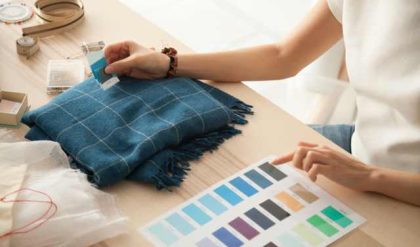Viscose fabric is one of many popular fabrics that exists and is commonly known as Rayon. Viscose material is man-made and created by weaving together fibers from cellulose that is chemically extracted from trees. Viscose makes light fabric, breathable, and great for warm summer weather. Manufacturers use a huge variety of fabric these days with different constructions, weights, sizes, and shapes. Some fabrics are natural, while others can be manufactured or synthetic. Some people do not understand what viscose is, which is why in this article we will explain everything there is to know about this fascinating fabric.
Viscose or Rayon?
Let us begin by talking about terminology. What is the relationship between viscose and rayon? Are viscose and rayon the same thing or are there any differences between them? Terminology can be confusing here but the explanation is clear: viscose and rayon are one and the same. Whether we talk about rayon or viscose, we are talking about the very same fabric. So, why two different terms for the same thing? Viscose is the international term, while rayon is the name that is used in the United States.
In the United States, you are far more likely to come across the term rayon while in other countries the preferred term in viscose. If you search the Internet for information on this fabric, you might come across both terms indistinctly as writers from different backgrounds might use one term over the other. But the important thing to know is that, more often than not, viscose and rayon are exactly the same fabric. Viscose is just a type of rayon.
The Origins of Viscose?
Viscose or rayon was first known as artificial silk. Its origins go back to the late 19th century. Later it became known as rayon, a term that was first introduced in 1924. It is important that every bride feels comfortable in her chosen dress, and fabric choice has a big part to play in this. – Emilia Wickstead The name “viscose” comes from the manner in which the fiber is manufactured. A viscous organic liquid is used for the manufacturing of rayon. The same viscous organic liquid is also used to make cellophane. The term viscose refers to a regenerated manufactured fiber, which is made from cellulose through the process that we have just described and that is known as the viscose process. The process through which viscose is manufactured makes this fabric into an in-between fiber that is not totally natural like, silk, wool, or cotton; but which is also not totally synthetic, like polyester or nylon, either.
Viscose: A Popular Fabric
There can be no doubt that viscose is a popular fabric. But, what makes it quite so popular? For one thing, viscose is a relatively low-cost fabric. But that is not the only reason why it is so popular. Part of the success of viscose is derived from the fact that this fabric has many different qualities. Because of its many qualities, viscose can be used mixed with velvet, taffeta and it cotton end used. But viscose is also found in some hygiene products. Viscose has many great characteristics including its versatility, its high level of absorption, its smoothness, its strength, its color retention, its breathability, its lightness, and its low cost. Viscose works very well with cotton because of the share a similar chemical make-up. But varicose can have different qualities from cotton according to how it is manufactured. The key to the uses, the qualities, and the popularity of viscose is in the way it is manufactured.
Viscose Comes From Cellulose
We could also say that its uses, qualities, and popularity are derived from cellulose. Why? Because cellulose or protein is what a fiber is manufactured. What is cellulose? Cellulose is the main component of plant walls. It is a carbohydrate. Not all fibers are the same. There is a key difference between manufacture and synthetic fibers, which has to do with sustainability. Unlike fully synthetic fabrics, manufactured fabrics such as viscose or rayon are made from wood pulp. And that is why they can be easily compared with other cellulosic fibers such as linen or cotton. As such, viscose is only partially man-made.
The main difference between cellulosic fibers and fully synthetic fibers is that fibers such as viscose are made from cellulose that occurs in nature and it is not manufactured. So, even those viscose goes through a manufacturing process (man-made), it is still made out of something that we find in nature. The only reason why we cannot consider viscose a natural fiber is because there is an extensive manufacturing process involved but it will be wrong to call it a synthetic or artificial fiber, either. And this is why viscose and rayon are often known as regenerated cellulose.
How Sustainable Is Viscose?
We mentioned sustainability earlier so let us know go deeper into it. Viscose has a good reputation for being sustainable and environmentally friendly because it is made from plants that are renewable. As we saw earlier, the origins of this fabric go back to the late 19th century. Starting in the year 1883, viscose, known then as “artificial silk” was a low-cost alternative to real silk. But how sustainable and environmentally friendly really is viscose? Can it live up to its good reputation?
To answer that question would need to look closer to the manufacturing process. The recycled wood that is used in the manufacturing process is treated with different chemicals, including ammonia, caustic soda, sulphuric acid, and acetone. So, while the source is one-hundred percent natural and sustainable, the fabric itself is made with many different chemicals. What this means is that viscose or rayon is relatively sustainable. It is definitely more sustainable than fully synthetic fibers. Also, manufacturing methods of viscose continue to improve. These days it is often made using N-Methylmorphine N-oxide, which makes the whole thing even more environmentally friendly as it produces a lot less waste.

